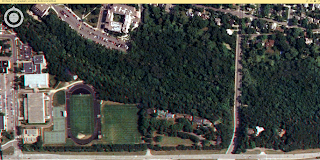INTRODUCTION
The following lab demonstrates the ability to measure and interpret spectral reflectance signatures of Earth surface features and materials and to perform basic monitoring of Earth resources using remote sensing band ratio techniques.
METHODOLOGY
Spectral Signature Analysis
All spectral images were collected from a Landsat ETM+ aerial image of Eau Claire, WI. Using ERDAS Imagine, all spectral images were first digitized, organized by the signature editor, and analyzed using the signature mean plot. The first surface feature digitized was Lake Wissota to give a general overview of the process. The list of additional features collected were:
- Standing water
- Moving water
- Riparian vegetation
- Crops
- Urban grass
- Dry soil
- Moist soil
- Rock
- Ashalt highway
- Airport runway
- Concrete surface
Resource Monitoring
To monitor vegetation health, the normalized difference vegetation index (NDVI) was used which subtracts the red band from NIR divided by the sum of the red band and NIR. The output image was then opened in ArcMap where the gradient was switched to an equal interval 5-class classisification system map.
The same process was repeated to monitor soil health, except using the ferrous minerals equation (MIR/NIR) instead of the NDVI.
RESULTS
Spectral Signature Analysis
Figure 1 shows the signature analysis process in ERDAS Imagine. The signature editor on the left displays all areas digitized while the mean plot on the right allows for analysis of the digitized feature.
 |
| Figure 1: Lake Wissota digitized with ERDAS signature editor and signature mean plot |
Figure 2 shows the signature mean plot for moving water collected by Putnam Rock on the Chippewa River. Water features absorb most energy and have low spectral reflectance as the wavelength increases. The reason for higher reflectance in the blue band is because of the shorter wavelength and the resulting scattering.
 |
| Figure 2: Signature mean plot for moving water in Eau Claire |
 |
| Figure 3: Signature mean plot for forest area in Eau Claire |
 |
| Figure 4: Signature mean plot for dry and moist soils in Eau Claire |
 |
| Figure 5: Signature mean plot for all features collected in Eau Claire |
 |
| Figure 6: Signature editor displaying all features collected in Eau Claire |
Crops, dry soil, and airport all show
similar trends of dipping reflectance on band 4, increasing to band 5 and then
decreasing again on band 6.
Forest, urban grass, and moist soil all
show similar trends of slowly decreasing from band 1 to band 3, followed by an
increase on band 4 and a decreasing reflectance to band 6. All of these have
moisture in them that reflects energy similar.
Concrete surface, standing water, and
moving water all show a similar trend of slowly decreasing reflectance from
band 1 to band 6. This could be because they all have very little reflectance
throughout all wavelengths.
Asphalt and rock are very similar in that
the reflectance is maintained from band 1 to band 4 and then peaks a little at
band 5. This could be because
Concrete has a unique spectral signature.
This is because of its unique composition of material.
Resource Monitoring
As shown by Figure 7, the spectral reflectance of the NDVI was re-classified in ArcMap to produce a map showing vegetation health in Eau Claire. This is a cheap and efficient way of vegetation monitoring and can be used for a vast number of purposes. The white in the image indicates an abundance of forest, while the black indicates areas that vegetation doesn't exist.
 |
| Figure 7: Map showing vegetation health in Eau Claire |
 |
| Figure 8: Map showing soil health in Eau Claire |
SOURCES
Satellite imagery is from Earth Resources Observation and Science Center, United States Geological Survey.








